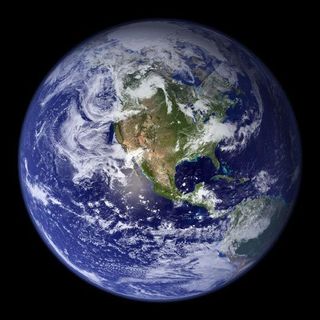What Is Something in Particular You Know About Earth
Earth: Facts About Our Planet

The Earth is our dwelling, the merely place in the universe where we know for sure that life exists. World formed a flake over iv.five billion years ago from a swirling cloud of gas and grit that gave ascension to our unabridged solar organisation, including our star, the sun. According to scientists' all-time theories, this gas and dust collapsed into a disk, with unlike parts of the disk coalescing into each of the planets in our solar system.
Where is Earth?
Our planet sits in a minor corner of the Milky way galaxy, 25,000 light-years from the galactic center and 25,000 light-years away from the rim, co-ordinate to Universe Today. Our solar system is situated on a pocket-sized arm called the Orion-Cygnus arm, which branches off from the Sagittarius arm, one of the milky way's ii major spiral arms.
The Earth's circumference is 24,901 miles (40,075 kilometers), making information technology the largest rocky planet in the solar system. Our planet orbits 93 million miles (150,000 km) abroad from the sun, giving it the right temperature for persistent liquid water on the surface, the merely known torso to exercise and so.
What is Earth made of?
Several enormous landforms known as continents exist in various places on the World's surface. The largest continent, which is sometimes known every bit Afro-Eurasia (though more than commonly cleaved up into Africa, Europe and Asia), has a full area of 32,800,000 square miles (84,950,000 square km), according to the Encyclopedia of World Geography. North and Southward America together contain 16,428,000 square miles (42 million square km), while the frozen continent of Antarctica is five,405,000 square miles (14 million square km) and the area of Commonwealth of australia is 2,970,000 square miles (7,656,127 foursquare km).
Processes beneath the Earth's chaff crusade these continents to move effectually over geological time periods. Geologists take discovered hole-and-corner continents buried deep below the surface, and though nobody quite knows how or when they formed, they may be every bit old every bit the Earth itself.
The Earth'south crust is a thin layer that extends on average around 18 miles (30 km) below our feet, containing more often than not silicate and basaltic rocks, according to the U.Southward. Geological Survey. The pall is the next layer down, extending to about 1,800 miles (ii,900 km) below the Earth'south surface. A common misconception is that all the rock in the curtain is melted into magma; in fact, most of it is in a highly viscous form that is so thick that it takes millions of years for its move to get credible. In the Earth's center is a nickel-iron cadre that is liquid on the outside, down to 1,400 miles (ii,260 km), but crushed by incredible pressures into a solid class at the lowest depths.
Earth'south temper
Our planet's atmosphere is 78% nitrogen, with an additional twenty% oxygen, 0.9% argon and 0.04% carbon dioxide, plus trace amounts of other gases, according to NASA. About man activity takes place in the lowest atmospheric layer, the troposphere, which extends 5 to nine miles (8 to 14.5 km) over our heads. Above that is the stratosphere, where clouds and weather balloons fly, going up to 31 miles (fifty km) high. This is followed past the mesosphere, which extends up to 53 miles (85 kilometers) high (this is where meteors burn up) and the thermosphere, which extends far out into space, at least 372 miles (600 km) loftier.
Human activity is greatly affecting climate and conditions in the Globe's atmosphere. By calculation excess carbon dioxide, which traps infrared radiation from the sunday, human manufacture is heating up our planet via global warming, leading to large-calibration alterations. Those include a rise in boilerplate temperatures by around 2.3 degrees Fahrenheit (1.3 degrees Celsius). September 2019 had some of the hottest recorded temperatures all over the World.
The Earth's surface
The Earth is tilted on its axis past 23.4 degrees, meaning that sunlight falls unevenly on the planet's surface over the form of the year, creating seasonal variation over most of the planet. But different regions experience different variances in sunlight, so the Globe's surface is often broken up into iii major climatic zones: the polar regions in the Chill and Antarctic, which start above or below 66 degrees breadth north or due south; the middle temperate zones, betwixt 23 and 66 degrees latitude north or south; and the tropical regions, between the Tropic of Cancer, at 23 degrees breadth n, and the Tropic of Capricorn, at 23 degrees breadth due south, according to the National Oceanic and Atmospheric Administration.
The tallest point in a higher place bounding main level is the peak of Mountain Everest. at 29,029 feet (8,848 meters). A crescent-shaped crevasse at the bottom of the western Pacific Ocean known every bit the Mariana Trench is the deepest spot on our planet, extending down to 36,037 anxiety (10,984 1000).
The Nile is the longest river in the world, winding for four,258 miles (6,853 km) through northeastern Africa. Lake Baikal in Russia is the largest and deepest freshwater lake, containing 5,521 cubic miles of h2o (23,013 cubic km) — a book approximately equivalent to that of all 5 of the Northward American Nifty Lakes combined.
Life on Earth
Maybe the most striking thing about the Earth, and the characteristic that and so far makes it unique throughout the known cosmos, is the presence of living organisms. Some of the oldest evidence of microbial life suggests that it was already widespread on our planet 3.95 billion years ago. Exactly how these microscopic creatures arose remains a mystery, though experts have proposed many theories.
Scientists approximate that there are as many every bit 1 trillion species on our planet, occupying niches that extend from the upper atmosphere to deep below the rocky surface. Baroque and circuitous biospheres exist around hydrothermal vents at the bounding main'due south bottom and in just near every rock and fissure always explored. Whether this ways that organisms be on the bounty of worlds in our solar system or beyond remains an open question, though the diversity of life on Earth has given scientists hope that life might exist in extreme environments throughout the universe.
Additional resource:
- 7 Ways to Prove the Globe Is Round (Without Launching a Satellite)
- 50 Interesting Facts About Earth
- Photos: Artistic Views of Earth from To a higher place
Source: https://www.livescience.com/earth.html

0 Response to "What Is Something in Particular You Know About Earth"
Post a Comment